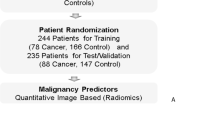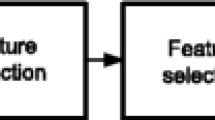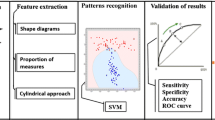Abstract
We analyze the importance of shape features for predicting spiculation ratings assigned by radiologists to lung nodules in computed tomography (CT) scans. Using the Lung Image Database Consortium (LIDC) data and classification models based on decision trees, we demonstrate that the importance of several shape features increases disproportionately relative to other image features with increasing size of the nodule. Our shaped-based classification results show an area under the receiver operating characteristic (ROC) curve of 0.65 when classifying spiculation for small nodules and an area of 0.91 for large nodules, resulting in a 26 % difference in classification performance using shape features. An analysis of the results illustrates that this change in performance is driven by features that measure boundary complexity, which perform well for large nodules but perform relatively poorly and do no better than other features for small nodules. For large nodules, the roughness of the segmented boundary maps well to the semantic concept of spiculation. For small nodules, measuring directly the complexity of hard segmentations does not yield good results for predicting spiculation due to limits imposed by spatial resolution and the uncertainty in boundary location. Therefore, a wider range of features, including shape, texture, and intensity features, are needed to predict spiculation ratings for small nodules. A further implication is that the efficacy of shape features for a particular classifier used to create computer-aided diagnosis systems depends on the distribution of nodule sizes in the training and testing sets, which may not be consistent across different research studies.






Similar content being viewed by others
References
American Cancer Society: Cancer facts and figures. Available at http://www.cancer.org/research/cancerfactsfigures/cancerfactsfigures/cancer-facts-figures 2013. Accessed December 2013
Aberle D, Adams A, Berg C, Black W, Clapp J, Fagerstrom R, Gareen I, Gatsonis C, Marcus P, Sicks J: Reduced lung-cancer mortality with low-dose computed tomography screening. N Engl J Med 246:697–722, 2008
Way T, Chan H-P, Hadjiiski L, Sahiner B, Chughtai A, Song TK, Poopat C, Stojanovska J, Frank L, Attili A, Bogot N, Cascade P, Kazerooni EA: Computer-aided diagnosis of lung nodules on CT scans: ROC study of its effects on radiologists’ performance. Acad Radiol 17(3):323–332, 2009
Li F, Li Q, Engelmann R, Aoyama M, Sone S, MacMahon H, Doi K: Improving radiologists’ recommendations with computer-aided diagnosis for management of small nodules detected by CT. Acad Radiol 13:943–950, 2006
Armato III, SG, McLennan G, Bidaut L, et al: The lung image database consortium (LIDC) and image database resource initiative (IDRI): a completed reference database of lung nodules on CT scans. Med Phys 38:915–931, 2011
Raicu DS, Varutbangkul E, Cisneros JG, Furst JD, Channin DS, Armato III, SG: Semantic and image content integration for pulmonary nodule interpretation in thoracic computed tomography. SPIE Medical Imaging, San Diego, 2007
Varutbangkul E, Raicu DS, Furst JD: A computer-aided diagnosis framework for pulmonary nodule interpretation in thoracic computed tomography. DePaul CTI Research Symposium, DePaul University, 2007
Muhammad MN, Raicu DS, Furst JD, Varutbangkul E: Texture versus shape analysis for lung nodule similarity in computed tomography studies. Medical Imaging 2008: PACS and Imaging Informatics, 2008
Kim R, Dasovich G, Bhaumik R, Brock R, Furst JD, Raicu DS: An investigation into the relationship between semantic and content based similarity using LIDC. MIR’10 Proceedings of the International Conference on Multimedia Information Retrieval, DOI: 10.1145/1743384.1743417, 185–192, 2010
Varutbangkul E, Mitrovic V, Raicu D, Furst J: Combining boundaries and ratings from multiple observers for predicting lung nodule characteristics. Int Conf Biocomput Bioinform BiomedTechnol 99:82–87, 2008
Horsthemke W, Raicu DS, Furst JD: Evaluation challenges for bridging the semantic gap: Shape Disagreements in the LIDC. Int J Healthcare Information Syst Inform, 2009
Zerhouni EA, Stitik FP, Siegelman SS, Naidich DP, Sagel SS, et al: CT of the pulmonary nodule: a cooperative study. Radiology 160:319–327, 1986
Zhao B, Gamsu G, Ginsburg MS, Jiang L, Schwartz LH: Automatic detection of small lung nodules on CT utilizing a local density maximum algorithm. J Appl Clini Med Phys 4(3):248–260, 2003
Zinovev D, Raicu D, Furst J, Armato III, SG: Predicting radiological panel opinions using a panel of machine learning classifiers. Algorithms 2:1473–1502, 2009
Goldin JG, Brown MS, Petkovska I: Computer-aided diagnosis in lung nodule assessment. J Thoracic Imaging 23(2), 2008
Quang L: Recent progress in computer-aided diagnosis of lung nodules on thin-section CT. Comput Med Imaging Graph 31(4–5):248–257, 2007
Guliato D, Rangayyan RM, Carvalho JD, Santiago SA: Polygonal modeling of contours of breast tumors with the preservation of spicules. IEEE Trans Biomed Eng 55, 2008
Guliato D, de Carvalho JD, Rangayyan RM, Santiago SA: Feature extraction from a signature based on the turning angle function for the classification of breast tumors. J Digit Imaging 21:129–144, 2008
Rangayyan RM, Mguyen TN: Fractal analysis of contours of breast masses in mammograms. J Digit Imaging 20:223–237, 2007
Langlotz CP: RadLex: a new method for indexing online educational materials. RadioGraphics 26:6, 2006
Marwede D, Schulz T, Kahn T: Indexing thoracic CT reports using a preliminary version of a standardized radiological lexicon (RadLex). J Digit Imaging 21:4, 2008
El-Baz A, Beache GM, Gimel’farb G, Sukuki K, Okada K, Elnakib A, Soliman A, Abdollahi B: Computer-aided diagnosis systems for lung cancers: Challenges and methodologies. Int J Biomed Imag, Article ID 9423533, 2013
Furuya K, Murauama S, Soeda H, Murakami J, Ichinose Y, Yabuuchi H, Katsuda Y, Koga M, Masuda K: New classification of small pulmonary nodules by margin characteristics on high-resolution CT. Acta Radiol 40:496–504, 1999
Nakamura K, Yoshida H, Engelmann R: Computerized analysis of the likelihood of malignancy in solitary pulmonary nodules with use of artificial neural networks. Radiology 214:823–830, 2000
Horsthemke WH, Raicu DS, Furst JD: Characterizing pulmonary nodule shape using a boundary-region approach. SPIE Medical Imaging, Orlando, 2009
Horsthemke WH, Raicu DS, Furst JD: Predicting LIDC diagnostic characteristics by combining spatial and diagnostic opinions, medical imaging 2010: Computer-Aided Diagnosis, Proceedings of SPIE, 7624, 2010
Wiemker R, Opfer R, Bulow T, Kabus S, Dharaiya E: Repeatability and noise robustness of spicularity features for computer aided characterization of pulmonary nodules in CT. SPIE Medical Imaging, San Diego, 2008
Weimker R, Bergtholdt M, Dharaiya E, Kabus S, Lee MC: Agreement of CAD features with expert observer ratings for characterization of pulmonary nodules in CT using the LIDC-IDRI database. SPIE Medical Imaging, San Diego, 2009
Kawata Y, Niki N, Ohmatsu H, et al: Classification of pulmonary nodules in thin-section CT images based on shape characterization. Proc Int Conf Imag Process 3(2):528–530, 1997
Kido S, Kuriyama K, Higashiyama M, Kasugai T, Kuroda C: Fractal analysis of small peripheral pulmonary nodules in thin-section CT: evaluation of lung nodule interfaces. J Comput Assist Tomogr 26(4):573–578, 2002
El-Baz A, Nitzken M, Vanbogaert E, Gimel’farb G, Faulk R, Abo El-Ghar M: A novel shape-based diagnostic approach for early diagnosis of lung nodules. IEEE Confeon Biomed Imag 137–140, 2011
Huang P-W, Lin P-L, Lee C-H, Kuo CH: A classification system of lung nodules in CT images based on fractional brownian motion model. IEEE International Conference on System Science and Engineering, July 4–6, 2013
Netto SMB, Silva AC, Nunes RA: Analysis of directional patterns of lung nodules in computerized tomography using Getis statistics and their accumulated forms as malignancy and benignity indicators. Pattern Recogn Lett 33:1734–1740, 2012
Way TW, Hadjiiski LM, Sahiner B, Chan H-P, Cascade PN, Kazerooni EA, Bogot N, Zhou C: Computer-aided diagnosis of pulmonary nodules in CT scans: segmentation and classification using 3D active contours. Med Phys 33(7):2323–2337, 2006
Way TW, Sahiner B, Chan H-P, Hadjiiski L, Casscade PN, Chughtai A, Bogot N, Kazerooni E: Computer-aided diagnosis of pulmonary nodules on CT scans: improvement of classification performance with nodule surface features. Med Phys 36(7):3086–3098, 2009
Suzuki K, Li F, Sone S, Doi K: Computer-aided diagnostic scheme for distinction between benign and malignant nodules in thoracic low-dose CT by use of massive training artificial neural network. IEEE Tran Med Imag 24:91138–1150, 2005
Sahiner B, Chan HP, Petrick N, Wei D, Helvie MA, Adler CDD, Goodsitt MM: Image feature selection by genetic algorithm: application to classification of mass and normal breast tissue on mammograms. Med Phys 23:1671–1684, 1996
Dorst F, Smeulders AWM: Length estimators for digitized contours. Computer Vision Graphs Imag Process 40:311–333, 1987
Koplowitz J, Bruckstein AM: Design of perimeter estimators for digitized planar shapes. IEEE Transactions on Pattern Analysis and Machine Intelligence 11(6), June 1989
Montero R, Briciesca E: State of the art of compactness and circularity measures. Int Mathematical Forum 4(27):1305–1335, 2009
Rosenfeld A: Compact figures in digital pictures. IEEE Trans Syst Ma Cybernetics 4(2):221–223, 1974
Lee SC, Wang Y, Lee ET: Compactness measure of digital shapes. Annual Technical and Leadership Workshop, 103–105, 2004
Haralick RM, Shanmugam K, Dinstein I: Textural features for image classification. IEEE Trans Syst Man Cybernet 3(6):610–621, 1973
Andrysiak T, Choras M: Image retrieval based on hierarchical gabor filters. Int J Appl Comput Sci 15(4):471–480, 2005
Breiman L, Friedman J, Olshen R, Stone C: Classification and regression trees. CRC Press, Boca Raton, 1984
Yen SJ, Lee YS: Cluster-based under-sampling approaches for imbalanced data distributions. Expert Syst Applic 36:5718–5727, 2009
Drummond C, Holte RC: C4.5, Class imbalance, and cost sensitivity: why under-sampling beats over-sampling. Workshop on Learning from Imbalanced Data Sets II, 2003
Rahman MM, Davis DN: Addressing the class imbalance problem in medical datasets. Int J Mach Learn Comput 3(2):224–228, 2013
Bogot NR, Kazerooni EA, Kelly AM, Quint LE, Desjardins B, Nan B: Interobserver and intraobserver variability in the assessment of pulmonary nodule size on CT using film and computer display methods. Acad Radiol 12:948–956, 2005
Chen H, Xu Y, Ma Y, Ma B: Neural network ensemble-based computer-aided diagnosis for differentiation of lung nodules on CT images. Acad Radiol 17:595–602, 2010
Shie, C-Z, Zhao Q, Luo L-P, He J-X: Size of solitary pulmonary nodule was the risk factor for malignancy. J Thorac Dis 6(6), 2014
Xu DM, van Klaveren RJ, de Bock GH, Leusveld A, Zhao Y, Wang Y, Vliegenthart R, de Koning HJ, Scholten ET, Verschakelen J, Prokop M, Oudkerk M: Limited value of shape, margin, and CT density in the discrimination between benign and malignant screen detected solid pulmonary nodules of the NELSON trial. Eur J Radiol 68(2):347–352, 2007
Author information
Authors and Affiliations
Corresponding author
Rights and permissions
About this article
Cite this article
Niehaus, R., Stan Raicu, D., Furst, J. et al. Toward Understanding the Size Dependence of Shape Features for Predicting Spiculation in Lung Nodules for Computer-Aided Diagnosis. J Digit Imaging 28, 704–717 (2015). https://doi.org/10.1007/s10278-015-9774-8
Published:
Issue Date:
DOI: https://doi.org/10.1007/s10278-015-9774-8




